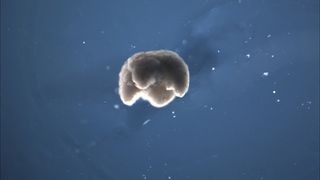

 (Image: © Douglas Blackiston, Tufts University)
(Image: © Douglas Blackiston, Tufts University)
What happens when you take cells from frog embryos and grow them into new organisms that were “evolved” by algorithms? You get something that researchers are calling the world’s first “living machine.”
Though the originalstem cellscame from frogs – the African clawed frog, Xenopus laevis
 Related:****************************************************** (The 6 Strangest Robots Ever Created)
Related:****************************************************** (The 6 Strangest Robots Ever Created)
“They’re neither a traditional robot nor a known species of animal,” study co-author Joshua Bongard, a computer scientist and robotics expert at the university of Vermont,

Algorithms shaped theevolution
of the xenobots. They grew from skin and heart stem cells into tissue clumps of several hundred cells that moved in pulses generated by heart muscle tissue, said lead study author Sam Kriegman, a doctoral candidate studying evolutionary robotics in the University of Vermont’s Department of Computer Science, in Burlington .

“Eventually, it was able to give us designs that actually were transferable to real cells. That was a breakthrough,” Kriegman said.

 (************************************************
(************************************************
“We can imagine many useful applications of these living robots that other machines can’t do,” said study co-author Michael Levin, director of the Center for Regenerative and Developmental Biology at Tufts University in Massachusetts. These might include targeting toxic spills or(radioactive) contamination, collecting marine microplastics or even excavating plaque from human arteries, Levin said in a statement.
Creations that blur the line between robots and living organisms are popular subjects in science fiction; think of the killer machines in the “Terminator” movies or the replicants from the world of “Blade Runner
.” The prospect of so-called living robots – and using technology to create living organisms – understandably raises concerns for some, said Levin.

“That fear is not unreasonable,” Levin said. “When we start to mess around with complex systems that we don’t understand, we’re going to get unintended consequences.”
The findings were published online Jan. in the journal
Proceedings of the National Academy of Sciences ************************************* (********************************************************************** (Underwater Drones – The Boom in Robotics Beneath the Waves
. (****************************************** (**********************************************(******************************************** (Read More) ******* ( (************************************************
(****************************************** (**********************************************(******************************************** (Read More) ******* ( (************************************************





GIPHY App Key not set. Please check settings